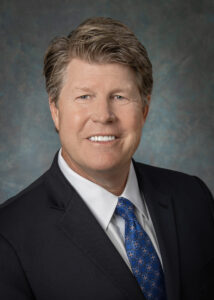Economists and bankers expect GDP growth will slow this year amid an ongoing exodus of Covid-19 stimulus dollars from the market and the impact of numerous interest rate hikes from the Federal Reserve to cool inflation.
Beyond that, the scope of a recession — or whether one will even occur — is subject to extensive debate.
“Predicting the future is kind of a fool’s errand, because we are highly unlikely to be right,” noted Mark Heinemann, president and CEO of Albert Lea, Minn.-based Arcadian Bank.
The $205 million bank has already had to adjust to high interest rates sparked by the Federal Open Market Committee’s raising of its federal funds rate to 5.25-5.50 percent from near-zero in March 2022.
“We’ve tried to adapt, and a lot of that just comes from building strong relationships and helping our customers understand what it is they can feasibly cash flow and what we’re comfortable with and making sure we understand what our asset values are and where the repayment sources are going to come from,” Heinemann added. “And that doesn’t really change whether it’s a strong economic cycle or a weak economic cycle.”
Recession or not?
KC Mathews, chief market strategist at Commerce Trust in Kansas City, Mo., sees a mild, short-lived recession as likely this year. He expects real GDP will increase 1 percent over the next 12 months, less than half the rate of its 2.4 percent growth in 2023. Unemployment, historically a lagging indicator of recession, is expected to rise above 4 percent from 3.7 percent in December 2023.

Mathews expects the Federal Reserve will begin cutting interest rates if the economy starts to fall into a recession, potentially in mid-2024, with its target federal funds rate falling 100 basis points by the end of the year to 4.50 percent.
“We are going to see an economic slowdown,” Mathews added. “Of course, Wall Street was really calling for a slowdown/recession [in 2023], and for a number of reasons it didn’t happen. But when we look at a number of economic variables, we do see a slowdown coming.”
Mathews called on community banks to have sufficient cash on hand to be prepared for any market downturn. “It’s not the first recession we’ve seen and it’s not going to be the last recession that we’ll see,” he added. “We’ll get through it, especially if we’re smart and a little defensive right now.”
Other economists are less certain that a recession will strike in 2024, partially due to the economy’s resilience during the Fed’s restrictive policy stance. Real GDP grew at a nearly 5 percent annualized clip in the third quarter. The stock market also enjoyed a strong year. The Dow Jones Industrial Average, S&P 500 and Nasdaq indexes have all increased by double digits.
Sparked by aggressive interest rate hikes from the FOMC, inflation has fallen closer to the committee’s long-term 2 percent target from its decades-high reading of 9.1 percent in June 2022. Commerce Trust expects core Personal Consumption Expenditures inflation to fall to 2.4 percent by the end of this year from 3.5 percent in October 2023.
The recent drop in inflation has increased chances of the FOMC cutting interest rates this year. On Dec. 13, the FOMC kept its target Federal Funds rate at 5.25-5.50 percent. Following the meeting, Federal Reserve officials indicated that three interest rate cuts are likely this year.
The U.S. economy added 150,000 jobs in October, which was a significant slowdown from the 260,000 monthly average in the previous months of the year. Despite slowed job growth in recent months, the labor market has not weakened enough to indicate an imminent recession, according to Commerce Trust’s 2024 economic outlook.
Another optimistic prognosis comes from Iselin, N.J.-based Provident Bank. The $14 billion bank conducted a 2024 economic outlook survey of owners and executives at businesses with at least $1 million in annual revenue. Seventy-one percent expect their businesses’ overall outlook to improve, and 62 percent said the broader economy will improve.
The majority of respondents expected hiring to increase this year due to sales growth; reasonable labor costs; a need for skills lacking in current staff and insufficient staffing levels to meet demand; an improved economic outlook; and expansion into a new segment or market.
Despite widespread predictions of a recession, both consumer and business spending remain strong, said Don Musso, president and CEO at Somerville, N.J.-based financial planning firm FinPro.
According to a Dec. 6 CliftonLarsenAllen economic forecast, GDP will continue to expand at a 2 percent to 3 percent clip this year. The hourlong webinar included Managing Principal for Investments Chris Dhanraj and Managing Principal of Industry Susan Roberts. Though Dhanraj and Roberts predicted unemployment to rise, they expected the increase to provide much-needed slack in the labor market and allow for more employees to change jobs.
The Federal Reserve Banks of St. Louis and Philadelphia recently released less cheery outlooks. The St. Louis Fed projects real GDP to fall to 1.3 percent this year from 2.6 percent in 2023. Nonfarm payroll employment is expected to slow, with unemployment rising to 4.2 percent from its average of 3.7 percent in the third quarter of last year.
St. Louis Fed Business Economist Kevin Kliesen said the heightened recession odds reflect several uncertainties, including the unknown impact of any additional interest rate hikes. Private forecasters surveyed by the St. Louis Fed late last year expected headline and core inflation to fall to 2.4 percent in 2024. “The expectation of below-trend real GDP growth in 2024 results in forecasts for slower — but still positive — job growth and a modest increase in the unemployment rate,” Kliesen added.
Private forecasters surveyed in November from the Philadelphia Fed estimated a 40 percent probability of negative real GDP growth over the first half of this year and an approximately 36 percent chance of negative growth in the second half. Those numbers both more than double the 15 percent average chance of recession on a historical basis.
No silver bullets
Cornerstone Advisors Senior Director Ryan Brogan called the economic outlook for this year “certainly a mixed bag,” but said he was more optimistic after the FOMC held the fed funds rate steady in December. “There’s still probably plenty of reason for caution,” he added. “There’s certainly some silver lining — or maybe a sigh of relief — as banks that have really struggled with cost of funds and liquidity all year see maybe a little bit of light at the end of the tunnel.”

Brogan still sees a looming economic downturn even after unemployment remained resiliently low over the past two and a half years amid an unprecedented stretch of stimulus funding. “People have been predicting that recession now for a couple of years, so who knows,” Brogan added.
He called on banks to adjust to the weakened economy by retaining existing depositors while growing their market share and expanding cross-sell relationships. To Brogan, banks must also understand their existing data and identify incomplete customer relationships. He expects the competition among banks to have the best certificate of deposit rate in the market to soon be exhausted if it hasn’t already.
“There’s not a silver bullet,” he added. “I think it’s, ‘How do we bring together your frontline relationship management and sales data, make sure of course that we’ve got digital capabilities,’ which is an area where many banks are still playing catch up. ‘How easy is it for me to open a new account or expand my relationship with the bank without having to come into the branch?’”
The next 12 months are also expected to bring an increase in real-time payments. Thirty-seven percent reportedly plan to both receive and send RTP in 2024, Musso said, with 24 percent not planning to do so. RTP adoption will likely continue to be modest as consumers aren’t immediately demanding RTP, but he expects they soon will. To Musso, RTP will eliminate treasury management solutions and continue to push physical dollars from the market, potentially leading to a digital dollar.
CLA’s Dhanraj said banks should transition to a merit-based pay scale this year. He advised banks to control debt costs, evaluate investing opportunities, pivot to longer maturity bonds, invest in infrastructure and employees as a shield from volatility, and diversify their holdings across public and private markets. He also called on banks to prepare for regulatory changes such as the sunsetting of the Tax Cuts and Jobs Act at the end of 2025 and accompanying increase in the top individual tax rate to 39.6 percent from 37 percent.
Not-so-green acres
Ag producers will likely see tighter profit margins in 2024 following several years of strong profits, said Kent Thiesse, a former senior vice president at Lake Crystal, Minn.-based MinnStar Bank who recently left to become an independent consultant. He expects gross income on corn production will be between $200 and $300 per acre less this year than in 2023. Livestock profit margins, which have been tight for the past 12-18 months, will likely continue to be limited.

Thiesse’s projections come after a mixed 2023 harvest across the Upper Midwest. Even as drought permeated the region, some areas were able to plant on time and catch timely rainfalls, securing some of their best yields on record with only 50-75 percent of normal rainfall amounts.
Though fertilizer and chemical expenses have dropped, Thiesse said corresponding gains will likely be partially offset by increased interest expenses and rising repair costs for machinery and equipment. He expects farmers will work with their lenders to market the relatively large amounts of stored grain, after low pre-harvest prices limited the selling market. Farmers are expected to fine-tune their cash flows this year, with some requiring closer attention because of tighter profit margins.
Arcadian Bank’s Heinemann said the strong ag economy in 2022-23 allowed farmers to pay down their lines of credit and fund the 2023 crop by mainly using cash. He added that the Albert Lea region was impacted by drought last year, causing some farmers to see lower-than-average yields. Still, farmers with strong crop insurance likely covered the shortfall as commodities prices remained lower than in previous years.
“Despite the concerns about drought, there still appears to be a pretty good amount of crop there,” Heinemann added. “Some places in the eastern Corn Belt had better yields, and didn’t have as many drought issues as we do around here.”
Facing down the ballot box
With elections about 10 months away, early polling has signaled that President Joe Biden and former President Donald Trump are likely to face off in a rematch of the contentious 2020 election, but that possibility has been complicated by the Colorado Supreme Court’s recent decision that Trump does not qualify for the ballot in the state for violating the Insurrection Clause. The U.S. Supreme Court is expected to hear the case Feb. 8, with a decision to follow soon after.
According to the FinPro survey, which was taken one day following the decision, 33 percent of financial professionals still expected Trump to win the presidency, compared to 23 percent who predicted a Biden reelection. Forty-four percent expected a new president from an unnamed party would be elected. Musso said a second term for Biden would ensure that “rules-driven, bank-antagonistic” agency heads will remain, while a Trump election would swing the pendulum to provide a more bank-friendly environment.
Roberts and Dhanraj see a Democratic-controlled Congress as unlikely to enact entitlement reform while continuing to add individual tax increases and a wealth tax. They expect a GOP-controlled Congress and White House will not raise taxes while potentially enacting entitlement reform. Republican control would likely entail Social Security reform and tax cuts.
